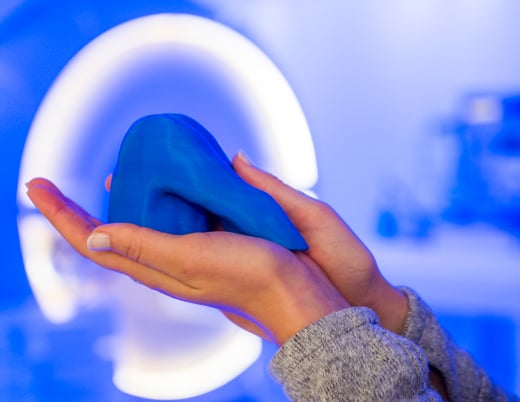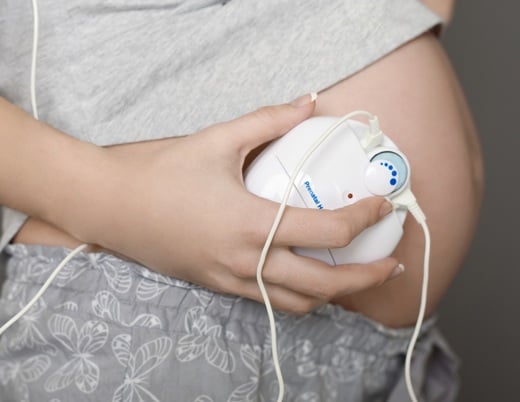Key takeaways
-
Fetal cardiologists at the Colorado Fetal Care Center participated in a multi-center study of anti-Ro/SSA antibody-mediated cardiac disease.
-
They examined the use of dexamethasone in fetal therapy to restore normal heart rhythm in fetuses with congenital heart block and improve outcome.
-
No difference in pregnancy complications between pregnancies treated with dexamethasone and those that were not.
-
Dexamethasone treatment decreased neonatal morbidity and overall mortality without increasing overall pregnancy complications.
Research background
In about 1% to 2% of pregnant women with anti-Sjögren's syndrome-related (anti-Ro/SSA) antibodies, the fetus will develop a complete atrioventricular block (CAVB). This condition may also be referred to as a complete heart block.
Of the affected fetuses, 20% will die and 50% of survivors will require permanent cardiac pacing by their first birthdays. In fetuses who develop dilated cardiomyopathy (DCM) or endocardial fibroelastosis (EFE), the mortality rate rises to 50% to 80%.
There is controversy surrounding current fetal therapy aimed at blocking progression to CAVB. Treatment includes the use of the steroid dexamethasone, which has known side effects in pregnancy. In addition, there is conflicting data on its efficacy.
The authors of this multi-institutional, retrospective, observational cohort study hypothesized that dexamethasone treatment for fetal anti-Ro/SSA antibody-mediated cardiac disease would be associated with better pregnancy outcomes compared to expectant management.
The Colorado Fetal Care Center was one of 14 centers that participated in the North American Fetal Therapy Network (NAFTNet) study. Bettina Cuneo, MD, former Director of Perinatal Cardiology and Fetal Cardiac Telemedicine at Children’s Hospital Colorado, contributed as a study author.
Research methods
Cohort
Each center retrospectively reviewed their fetal cardiology charts and echocardiogram images from patients with anti-Ro/SSA antibody-positive pregnancies and fetal conduction system disease and/or fetal myocardial dysfunction (EFE), between 2010 and 2018.
Fetal conduction system disease included:
- Sinus node dysfunction
- AVB or junctional ectopic tachycardia
- Myocardial dysfunction or EFE diagnosed by echocardiography during the study period
Echocardiography
M-mode or Doppler echocardiography was used to determine fetal heart rate and rhythm. Fetal mechanical Doppler atrioventricular (AV) interval measurement defined degree of AVB:
- 2º AVB: Regular atrial rhythm with the intermittent loss of conduction to the ventricle
- 3º AVB: AV dissociation with no observed AV conduction
Echocardiography determined EFE by areas of persistently increased echogenicity of papillary muscles, atria, AV groove and endocardial surfaces.
Treatment and primary outcomes
Centers recorded medications administered to treat fetal and maternal disease. They then evaluated charts for the presence or absence of pregnancy complications, including maternal comorbidities and medication side effects through delivery.
Fetal disease medications:
- Dexamethasone
- IVIG
- Beta-mimetics
Maternal disease medications:
- Hydroxychloroquine
- Azathioprine
- Prednisone
The primary outcome — poor pregnancy outcome — was defined as:
- Preterm delivery
- New maternal comorbidities
- New onset or worsening gestational diabetes
- New hypertensive disorder
- Oligohydramnios
- Fetal growth restriction
- Fetal death
Secondary outcomes included:
- Fetal morbidity
- Heart block, mitral or tricuspid regurgitation, abnormal ventricular function, EFE, effusions, hydrops
- Neonatal mortality or morbidity
- Including permanent pacemaker insertion <28 days or heart transplantation in the first year of life
Results
In the cohort of 127 pregnant women, 98 were treated with dexamethasone. Fifteen mothers had history of a prior fetus with conduction system disease or neonatal lupus.
Of note:
- There were significant differences in maternal race/ethnicity, prevalence of CHB in the fetus, and presence of hydrops.
- No difference in the number treated with hydroxychloroquine for prophylaxis.
- One patient not treated with dexamethasone received IVIG therapy, 20 patients received IVIG and dexamethasone.
Primary outcomes
In the group treated with dexamethasone, 63.5% met a primary outcome:
- 49.4% premature deliveries
- 20 mothers developed comorbidities during pregnancy
- 5 fetal deaths
- 10 growth restrictions
- 14 oligohydramnios
- 2 new/worsening gestational diabetes
In the group not treated with dexamethasone, 60% met a primary outcome:
- 50% experienced premature deliveries
- 4 developed comorbidities during pregnancy
- 3 fetal deaths
- 1 growth restriction
- 1 new onset maternal hypertension
Secondary outcomes
In the group treated with dexamethasone:
- 11.5% perinatal mortality rate (excluding terminations)
- 12% transient/sustained improvement in AV conduction in fetuses with 1° and 2° AVB at diagnosis
- 26% of pregnancies with functional abnormalities improved overall fetal cardiac status during treatment
- 43% surviving required pacemaker or died by 28 days old
- 28% of surviving treated infants required a pacemaker prior to 28 days of life
- 0 treated in utero required heart transplant
- 89% survived without cardiac transplant (excluding terminations)
In the group not treated with dexamethasone:
- 24% perinatal mortality rate (excluding terminations)
- 3% transient/sustained improvement in AV conduction in fetuses with 1° and 2° AVB at diagnosis
- 52% of surviving infants required pacemaker, died by 28 days old or were listed for transplant
- 41% of surviving treated infants required a pacemaker prior to 28 days of life
- 9.1% not treated in utero required heart transplant
- 68% survived without transplant (excluding terminations)
Other findings:
- The odds of fetal survival (adjusted for maternal/ethnicity, excluding terminations) for the group treated with dexamethasone compared to the group not treated with dexamethasone was 1.5.
- The group treated with dexamethasone had an increased rate of prenatal comorbidities and complaints including several attributed to high-dose fluorinated steroids, but there was no demonstrated significance between groups.
- There were no differences in gestational age at birth or birth weight between the two groups.
Discussion and conclusion: Dexamethasone did not change pregnancy outcomes, but improved overall fetal status in some
Dexamethasone use in anti-Ro/SSA positive pregnancies is associated with a high rate of poor pregnancy outcomes, but the study demonstrated a similarly high rate in untreated anti-Ro/SSA positive pregnancies. This suggests the maternal disease independently influences pregnancy complications.
There was no difference in fetal survival, but overall fetal cardiac status (valve regurgitation, function, effusions, EFE) improved in 26% of pregnancies treated with dexamethasone and one pregnancy treated with IVIG alone.
Studies of effects of dexamethasone treatment with or without maternal IVIG in this population on longer-term functional and neurodevelopmental status are needed.
Featured Researchers
Bettina Cuneo, MD
Fetal cardiologist





 720-777-0123
720-777-0123










